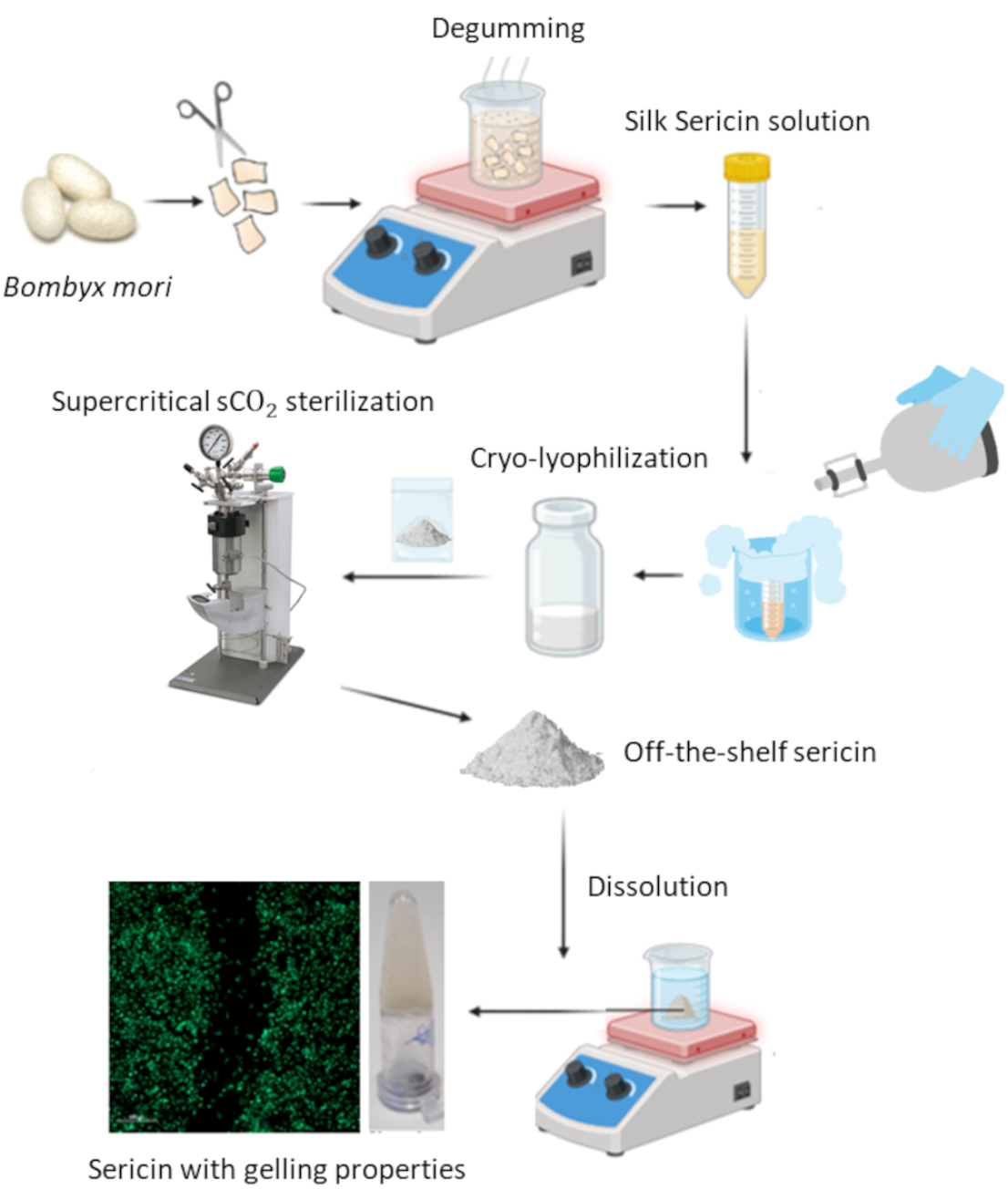La sericina de seda (SS), un subproducto de la industria textil, ha despertado un gran interés por su potencial biomédico debido a su biocompatibilidad y capacidad regenerativa. Sin embargo, la literatura carece de información sobre los métodos de procesamiento de la SS y las propiedades fisicoquímicas resultantes. Este estudio representa el primer paso hacia la optimización y estandarización de protocolos. En el presente trabajo, se estudiaron y compararon diferentes técnicas de procesamiento aplicadas a la SS extraída mediante ebullición en agua: evaporación, evaporación rotatoria, liofilización y diálisis, obteniéndose un rendimiento de recuperación de aproximadamente 27–32%. El objetivo fue identificar el método más prometedor para concentrar las soluciones de SS extraídas y garantizar que su estructura se preservara en gran medida. Como resultado, se propuso una nueva metodología de crio-liofilización. Este método permite la conservación de la estructura amorfa, lo que aporta ventajas significativas, como su completa disolución en agua y PBS, un aumento en la estabilidad de almacenamiento y la posibilidad de escalado, lo que lo hace altamente adecuado para aplicaciones industriales y biomédicas. La segunda parte del estudio se centró en abordar otro desafío en el procesamiento de la SS: una esterilización eficiente y no destructiva. En los últimos años, el CO₂ supercrítico (scCO₂) ha ganado relevancia como técnica de esterilización de biopolímeros y materiales biológicos sensibles debido a su ausencia de toxicidad y sus condiciones de procesamiento suaves. Por ello, se validó el scCO₂ como una técnica eficaz para la esterilización terminal de la SS. De este modo, se logró desarrollar un proceso secuencial de crio-liofilización/esterilización con scCO₂ que permitió preservar las propiedades originales de esta proteína natural de seda. En general, hemos valorizado la SS transformándola en un material estéril, listo para su uso, bioactivo y soluble en agua, con un gran potencial para su aplicación en las industrias biomédica, farmacéutica o cosmética.
3729048
{3729048:XDZUWTLX}
1
nature
50
default
1
1
1851
http://www.biomateriales.ictp.csic.es/wp-content/plugins/zotpress/
%7B%22status%22%3A%22success%22%2C%22updateneeded%22%3Afalse%2C%22instance%22%3Afalse%2C%22meta%22%3A%7B%22request_last%22%3A0%2C%22request_next%22%3A0%2C%22used_cache%22%3Atrue%7D%2C%22data%22%3A%5B%7B%22key%22%3A%22XDZUWTLX%22%2C%22library%22%3A%7B%22id%22%3A3729048%7D%2C%22meta%22%3A%7B%22creatorSummary%22%3A%22Veiga%20et%20al.%22%2C%22parsedDate%22%3A%222025-02%22%2C%22numChildren%22%3A1%7D%2C%22bib%22%3A%22%3Cdiv%20class%3D%5C%22csl-bib-body%5C%22%20style%3D%5C%22line-height%3A%202%3B%20%5C%22%3E%5Cn%20%20%3Cdiv%20class%3D%5C%22csl-entry%5C%22%20style%3D%5C%22clear%3A%20left%3B%20%5C%22%3E%5Cn%20%20%20%20%3Cdiv%20class%3D%5C%22csl-left-margin%5C%22%20style%3D%5C%22float%3A%20left%3B%20padding-right%3A%200.5em%3B%20text-align%3A%20right%3B%20width%3A%201em%3B%5C%22%3E1.%3C%5C%2Fdiv%3E%3Cdiv%20class%3D%5C%22csl-right-inline%5C%22%20style%3D%5C%22margin%3A%200%20.4em%200%201.5em%3B%5C%22%3EVeiga%2C%20A.%20%3Ci%3Eet%20al.%3C%5C%2Fi%3E%20Innovative%20Processing%20and%20Sterilization%20Techniques%20to%20Unlock%20the%20Potential%20of%20Silk%20Sericin%20for%20Biomedical%20Applications.%20%3Ci%3EGels%3C%5C%2Fi%3E%20%3Cb%3E11%3C%5C%2Fb%3E%2C%20114%20%282025%29.%20%3Ca%20title%3D%27Cite%20in%20RIS%20Format%27%20class%3D%27zp-CiteRIS%27%20href%3D%27http%3A%5C%2F%5C%2Fwww.biomateriales.ictp.csic.es%5C%2Fwp-content%5C%2Fplugins%5C%2Fzotpress%5C%2Flib%5C%2Frequest%5C%2Frequest.cite.php%3Fapi_user_id%3D3729048%26amp%3Bitem_key%3DXDZUWTLX%27%3ECite%3C%5C%2Fa%3E%20%20%3Ca%20title%3D%27Download%27%20class%3D%27zp-DownloadURL%27%20href%3D%27http%3A%5C%2F%5C%2Fwww.biomateriales.ictp.csic.es%5C%2Fwp-content%5C%2Fplugins%5C%2Fzotpress%5C%2Flib%5C%2Frequest%5C%2Frequest.dl.php%3Fapi_user_id%3D3729048%26amp%3Bdlkey%3DM6S6K6PE%26amp%3Bcontent_type%3Dapplication%5C%2Fpdf%27%3EDownload%3C%5C%2Fa%3E%3C%5C%2Fdiv%3E%5Cn%20%20%3C%5C%2Fdiv%3E%5Cn%3C%5C%2Fdiv%3E%22%2C%22data%22%3A%7B%22itemType%22%3A%22journalArticle%22%2C%22title%22%3A%22Innovative%20Processing%20and%20Sterilization%20Techniques%20to%20Unlock%20the%20Potential%20of%20Silk%20Sericin%20for%20Biomedical%20Applications%22%2C%22creators%22%3A%5B%7B%22creatorType%22%3A%22author%22%2C%22firstName%22%3A%22Anabela%22%2C%22lastName%22%3A%22Veiga%22%7D%2C%7B%22creatorType%22%3A%22author%22%2C%22firstName%22%3A%22Rosa%20Ana%22%2C%22lastName%22%3A%22Ram%5Cu00edrez-Jim%5Cu00e9nez%22%7D%2C%7B%22creatorType%22%3A%22author%22%2C%22firstName%22%3A%22V%5Cu00edctor%22%2C%22lastName%22%3A%22Santos-Rosales%22%7D%2C%7B%22creatorType%22%3A%22author%22%2C%22firstName%22%3A%22Carlos%20A.%22%2C%22lastName%22%3A%22Garc%5Cu00eda-Gonz%5Cu00e1lez%22%7D%2C%7B%22creatorType%22%3A%22author%22%2C%22firstName%22%3A%22Maria%20Rosa%22%2C%22lastName%22%3A%22Aguilar%22%7D%2C%7B%22creatorType%22%3A%22author%22%2C%22firstName%22%3A%22Luis%22%2C%22lastName%22%3A%22Rojo%22%7D%2C%7B%22creatorType%22%3A%22author%22%2C%22firstName%22%3A%22Ana%20L.%22%2C%22lastName%22%3A%22Oliveira%22%7D%5D%2C%22abstractNote%22%3A%22Silk%20sericin%20%28SS%29%2C%20a%20by-product%20of%20the%20textile%20industry%2C%20has%20gained%20significant%20attention%20for%20its%20biomedical%20potential%20due%20to%20its%20biocompatibility%20and%20regenerative%20potential.%20However%2C%20the%20literature%20lacks%20information%20on%20SS%20processing%20methods%20and%20the%20resulting%20physicochemical%20properties.%20This%20study%20represents%20the%20first%20step%20in%20protocol%20optimization%20and%20standardization.%20In%20the%20present%20work%2C%20different%20processing%20techniques%20were%20studied%20and%20compared%20on%20SS%20extracted%20from%20boiling%20water%3A%20evaporation%2C%20rotary%20evaporation%2C%20lyophilization%2C%20and%20dialysis%2C%20which%20presented%20a%20recovery%20yield%20of%20approximately%2027%5Cu201332%25.%20The%20goal%20was%20to%20find%20the%20most%20promising%20process%20to%20concentrate%20extracted%20SS%20solutions%2C%20and%20to%20ensure%20that%20the%20SS%20structure%20was%20highly%20preserved.%20As%20a%20result%2C%20a%20new%20cryo-lyophilization%20methodology%20was%20proposed.%20The%20proposed%20method%20allows%20for%20the%20preservation%20of%20the%20amorphous%20structure%2C%20which%20offers%20significant%20advantages%20including%20complete%20dissolution%20in%20water%20and%20PBS%2C%20an%20increase%20in%20storage%20stability%2C%20and%20the%20possibility%20of%20scaling-up%2C%20making%20it%20highly%20suitable%20for%20industrial%20and%20biomedical%20applications.%20The%20second%20part%20of%20the%20work%20focused%20on%20addressing%20another%20challenge%20in%20SS%20processing%3A%20efficient%20and%20non-destructive%20sterilization.%20Supercritical%20CO2%20%28scCO2%29%20has%20been%20gaining%20momentum%20in%20the%20last%20years%20for%20sterilizing%20sensitive%20biopolymers%20and%20biological%20materials%20due%20to%20its%20non-toxicity%20and%20mild%20processing%20conditions.%20Thus%2C%20scCO2%20technology%20was%20validated%20as%20a%20mild%20technique%20for%20the%20terminal%20sterilization%20of%20SS.%20In%20this%20way%2C%20it%20was%20possible%20to%20engineer%20a%20sequential%20cryo-lyophilization%5C%2FscCO2%20sterilization%20process%20which%20was%20able%20to%20preserve%20the%20original%20properties%20of%20this%20natural%20silk%20protein.%20Overall%2C%20we%20have%20valorized%20SS%20into%20a%20sterile%2C%20off-the-shelf%2C%20bioactive%2C%20and%20water-soluble%20material%2C%20with%20the%20potential%20to%20be%20used%20in%20the%20biomedical%2C%20pharmaceutical%2C%20or%20cosmetic%20industries.%22%2C%22date%22%3A%222025%5C%2F2%22%2C%22language%22%3A%22en%22%2C%22DOI%22%3A%2210.3390%5C%2Fgels11020114%22%2C%22ISSN%22%3A%222310-2861%22%2C%22url%22%3A%22https%3A%5C%2F%5C%2Fwww.mdpi.com%5C%2F2310-2861%5C%2F11%5C%2F2%5C%2F114%22%2C%22collections%22%3A%5B%5D%2C%22dateModified%22%3A%222025-02-06T12%3A06%3A55Z%22%7D%7D%5D%7D
1.
Veiga, A.
et al. Innovative Processing and Sterilization Techniques to Unlock the Potential of Silk Sericin for Biomedical Applications.
Gels 11, 114 (2025).
Cite Download

